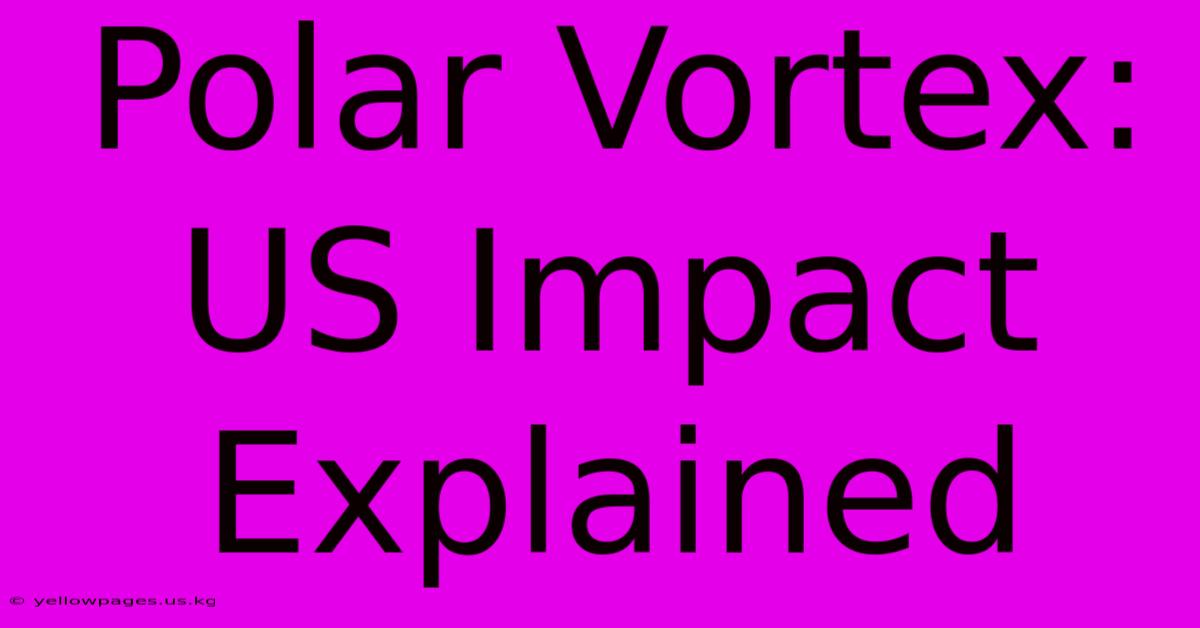Polar Vortex: US Impact Explained

Discover more detailed and exciting information on our website. Click the link below to start your adventure: Visit Best Website trendingnews.us.kg. Don't miss out!
Table of Contents
Polar Vortex: US Impact Explained
The polar vortex. It's a term that often sends shivers down the spines of Americans, conjuring images of record-breaking cold snaps and crippling blizzards. But what exactly is the polar vortex, and why does it impact the United States so dramatically? This article breaks down the science behind this weather phenomenon and explains its effects on the US.
Understanding the Polar Vortex
The polar vortex isn't a singular event; it's a persistent, large-scale circulation of cold air that resides high in the atmosphere over both the North and South Poles. Think of it as a giant, swirling mass of frigid air, typically contained within the stratosphere. This vortex is largely responsible for the generally colder temperatures experienced at high latitudes.
The Stratospheric vs. Tropospheric Polar Vortex: Key Differences
It's crucial to distinguish between the stratospheric and tropospheric polar vortices. The stratospheric polar vortex, located higher in the atmosphere, is more stable and less directly responsible for the extreme weather events we experience at ground level. The tropospheric polar vortex, closer to the surface, is weaker and more prone to disruption. It's this tropospheric vortex's instability that often leads to the severe weather conditions affecting the US.
How the Polar Vortex Impacts the US
The polar vortex's impact on the US is largely determined by its stability and the strength of the jet stream. The jet stream is a high-altitude river of fast-moving air that separates cold Arctic air from warmer air at lower latitudes.
Disruptions and the "Dips" in the Jet Stream
Normally, the jet stream keeps the cold Arctic air contained. However, when the jet stream weakens or becomes wavy, it allows cold air from the polar vortex to plunge southward, creating significant temperature drops across the US. These southward dips are often referred to as "polar vortex outbreaks."
Consequences of Polar Vortex Outbreaks
These outbreaks can bring about:
- Record-low temperatures: Cities can experience temperatures far below their historical averages, leading to widespread disruptions.
- Heavy snowfall and blizzards: The influx of cold, moist air can lead to significant snowfall and blizzard conditions, especially in areas prone to lake-effect snow.
- Dangerous wind chills: The combination of cold temperatures and strong winds creates dangerously low wind chills, posing serious risks to human health.
- Power outages: Extreme cold can strain power grids, resulting in widespread outages.
- Economic disruptions: Severe weather can disrupt transportation, business operations, and supply chains, leading to economic losses.
Predicting Polar Vortex Events
Predicting the behavior of the polar vortex and its potential impact on the US is a complex undertaking. Meteorologists utilize advanced computer models and satellite data to monitor the jet stream, the polar vortex's strength, and other atmospheric factors. While predicting the exact timing and intensity of polar vortex outbreaks remains challenging, improved forecasting techniques are constantly being developed.
Preparing for a Polar Vortex Event
Being prepared is crucial when a polar vortex event is anticipated. Here are some key steps you can take:
- Monitor weather forecasts: Stay informed about weather alerts and advisories from reputable sources.
- Protect your home: Insulate pipes, prepare for potential power outages, and secure your property.
- Stock up on supplies: Have enough food, water, medications, and other essentials on hand.
- Dress warmly: Wear layers of clothing to stay warm in extreme cold.
- Check on vulnerable individuals: Ensure that elderly neighbors, family members, and others at risk are safe and prepared.
The polar vortex is a powerful weather phenomenon with the potential to significantly impact the United States. While understanding its intricacies and predicting its behavior remains a challenge, staying informed and prepared can help mitigate its potential effects. By understanding the science and taking appropriate precautions, we can lessen the impact of these cold and disruptive events.

Thank you for visiting our website wich cover about Polar Vortex: US Impact Explained. We hope the information provided has been useful to you. Feel free to contact us if you have any questions or need further assistance. See you next time and dont miss to bookmark.
Featured Posts
-
Contract Extension For Pat Ferschweiler
Jan 01, 2025
-
Valentine Suffers Injury Illinois Vs South Carolina
Jan 01, 2025
-
Todays College Football Bowl Games
Jan 01, 2025
-
Predicting South Carolina Illinois Game Score
Jan 01, 2025
-
What College Games Are On
Jan 01, 2025
